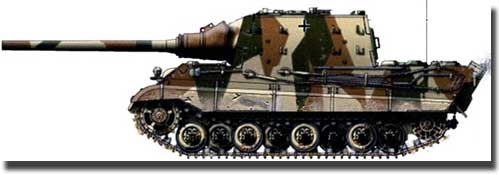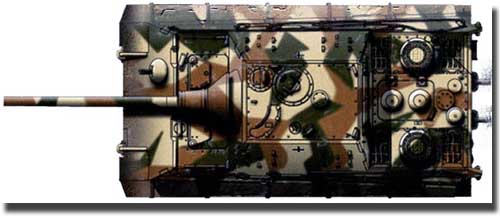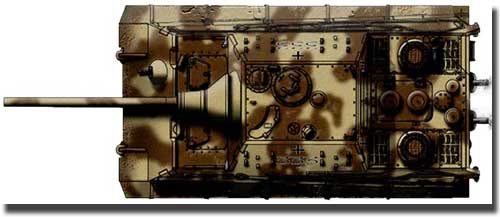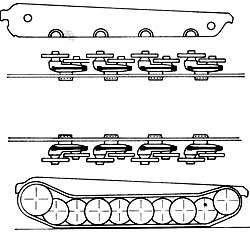
Jagdtiger tank destroyer
Jagdtiger tank destroyertank destroyer Tiger (Sd.Kfz.186);
The tank destroyer "Jagdtigr" had exceptionally strong armor: the forehead of the hull - 150 mm, the forehead of the cabin - 250 mm, the side walls of the hull and cabin - 80 mm. As a result, the weight of the vehicle reached 70 tons and it became the heaviest serial combat vehicle of the Second World War. Such a large weight adversely affected its mobility, heavy loads on the undercarriage caused it to break. Jagdtiger. History of creationExperimental design work on the design of heavy self-propelled systems has been carried out in the Reich since the beginning of the 40s and even crowned with local success - two 128-mm self-propelled guns VK 3001 (H) in the summer of 1942 were sent to the Soviet-German front, where, along with other equipment 521 th tank destroyer division were abandoned by the Wehrmacht after the defeat of the German troops in early 1943 near Stalingrad.
Jagdtiger # 1, prototype with Porsche suspension But even after the death of the 6th Army of Paulus, no one thought to launch such self-propelled guns in a series - the public mood of the ruling circles, the army, and the population was determined by the idea that the war would soon end in a victorious end. Only after the defeats in North Africa and on the Kursk Bulge, the landing of the allies in Italy, many Germans, blinded by quite effective Nazi propaganda, realized the reality - the combined forces of the countries of the Anti-Hitler coalition are much more powerful than the capabilities of Germany and Japan, therefore only a “miracle” can save the dying German state.
Jagdtiger # 2, prototype with Henschel suspension Immediately, among the population, conversations began about a “miracle weapon” that could change the course of the war - such rumors were quite legally spread by the Nazi leadership, which promised the people an early change in the situation at the front. Since there were no globally effective (nuclear weapons or its equivalent) military developments in the final stage of readiness in Germany, the leaders of the Reich “grabbed” for any significant military-technical projects, capable of, along with defensive ones, also performing psychological functions, inspiring the population with thoughts about the power and strength of the state. capable of initiating the creation of such complex technology. It was in such a situation that a heavy tank destroyer, the self-propelled guns Yagd-Tigr, was designed and then put into production.
Sd.Kfz.186 Jagdpanzer VI Ausf B Jagdtiger (Порше) When developing the Tiger II heavy tank, the Henschel company, in cooperation with the Krupp company, began to create a heavy assault gun based on it. Although the order for the creation of a new self-propelled gun was issued by Hitler in the fall of 1942, preliminary design began only in 1943. It was supposed to create an armored self-propelled art system armed with a 128-mm long-barreled gun, which, if necessary, could be equipped with a more powerful gun (it was planned to install a 150-mm howitzer with a barrel length of 28 calibers). The experience of creating and using the Ferdinand heavy assault gun was carefully studied. So, as one of the options for the new vehicle, the project of re-equipping the Elefant with the 128-mm Cannon 44 L / 55 was considered, but the point of view of the weapons department won, which proposed using the undercarriage of the projected heavy tank Tiger II as a tracked base for self-propelled guns. .
Sd.Kfz.186 Jagdpanzer VI Ausf B Jagdtiger (Порше) The new self-propelled guns were classified as "12,8 cm heavy assault gun". It was planned to equip it with a 128-mm artillery system, the high-explosive fragmentation ammunition of which had a significantly greater high-explosive effect than that of an anti-aircraft gun of a similar caliber Flak40. A full-size wooden model of the new self-propelled gun was demonstrated to Hitler on October 20, 1943 at the Aris training ground in East Prussia. The self-propelled guns made the most favorable impression on the Fuhrer and an order was given to start its serial production next year.
Sd.Kfz.186 Jagdpanzer VI Ausf.B Jagdtiger (Henschel) production variant On April 7, 1944, the car was named “Panzer-Jaeger Tiger” version В and index Sd.Kfz.186. Soon the name of the car was simplified to Jagd-tiger (“Yagd-tiger” - a hunting tiger). It was with this name that the above-described machine entered the history of tank building. The initial order was 100 self-propelled guns. Already by April 20, for the Fuehrer's birthday, the first sample was made in metal. The total combat weight of the vehicle reached 74 tons (with a Porsche chassis). Of all the serial self-propelled guns that participated in World War II, this one was the most difficult.
Sd.Kfz.186 Jagdpanzer VI Ausf.B Jagdtiger (Henschel) production variant The Krupp and Henschel companies were developing the design of the Sd.Kfz.186 self-propelled gun, and production was going to be launched at the Henschel factories, as well as at the Nibelungenwerke enterprise, which was part of the Steyr-Daimler AG concern. However, the cost of the reference sample turned out to be extremely high, so the main task set by the board of the Austrian concern was to achieve the maximum possible reduction in the cost of the serial sample and the production time for each tank destroyer. Therefore, the design bureau of Ferdinand Porsche (“Porsche AG”) took up the refinement of the self-propelled guns.
Since the most time-consuming part in the tank destroyer was precisely the “chassis”, Porsche proposed using a suspension in the car, which had the same design principle as the suspension installed on the “Elephant”. However, due to the many years of conflict between the designer and the weapons department, the consideration of the issue was delayed until the autumn of 1944, until finally a positive conclusion was received. Therefore, the Yagd-Tigr self-propelled guns had two types of chassis that differed from each other - Porsche designs and Henschel designs. The rest of the produced cars differed from each other by minor design changes. Back – Forward >> | |||||||||||||

 The tank destroyer "Jagdtigr" was created on the basis of the heavy tank T-VI V "Royal Tiger". Its hull is made with approximately the same configuration as that of the Jagdpanther tank destroyer. This tank destroyer was armed with a 128 mm semi-automatic anti-aircraft gun without a muzzle brake. The initial speed of her armor-piercing projectile was 920 m / s. Although the gun was designed to use separate loading shots, its rate of fire was quite high: 3-5 rounds per minute. In addition to the gun, the tank destroyer had a 7,92 mm machine gun mounted in a ball bearing in the frontal hull plate.
The tank destroyer "Jagdtigr" was created on the basis of the heavy tank T-VI V "Royal Tiger". Its hull is made with approximately the same configuration as that of the Jagdpanther tank destroyer. This tank destroyer was armed with a 128 mm semi-automatic anti-aircraft gun without a muzzle brake. The initial speed of her armor-piercing projectile was 920 m / s. Although the gun was designed to use separate loading shots, its rate of fire was quite high: 3-5 rounds per minute. In addition to the gun, the tank destroyer had a 7,92 mm machine gun mounted in a ball bearing in the frontal hull plate.







